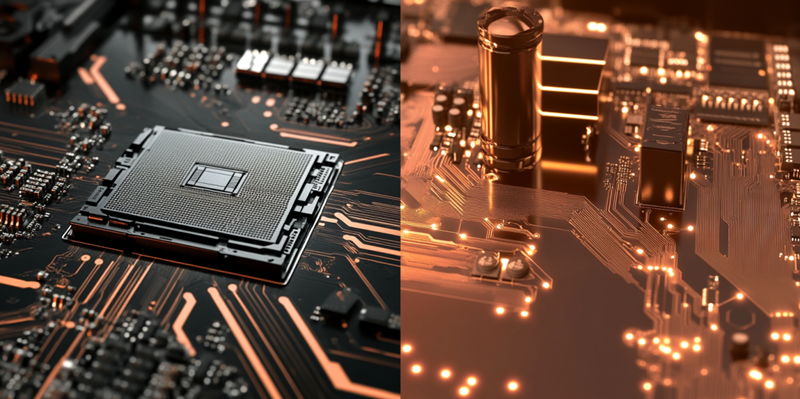The ongoing rivalry between AMD and Intel in the desktop CPU market has taken a dramatic turn, with AMD currently leading the race in terms of sales and consumer preferences. According to Amazon’s bestseller list, AMD dominates the entire top 10 spots for CPUs, leaving Intel’s first entry, the Core i5-13600KF, at a distant 13th position. Similarly, on Newegg, while Intel appears more frequently in the top 20, AMD still holds a commanding lead. This market shift indicates a broader trend towards AMD’s Ryzen processors, which have become synonymous with reliability and high performance, particularly in the gaming sector.
Consumers are turning to AMD not only because of the performance edge their CPUs offer but also due to Intel’s recent difficulties. Intel’s latest generation processors have been plagued by issues, including instability and less favorable reception from consumers. These challenges have allowed AMD to capitalize and prove the effectiveness of its strategic advantages, driving strong demand for its Ryzen lineup. The Ryzen 5700X, 5600X, 7800X3D, and the newly released 9800X3D are prime examples of products that have won over consumers, despite some models facing stock shortages due to overwhelming demand.
AMD’s Strategy and Market Position
AMD’s dominance in the desktop CPU market is no coincidence. The company’s strategic approach has paved the way for its current success. By focusing on performance, reliability, and value, AMD has crafted a portfolio that appeals to various segments of the market, from casual users to hardcore gamers. This strategy is evident in the popularity of the Ryzen series, known for its multi-core capabilities and excellent price-to-performance ratio, which has resonated well with the market. AMD’s effective handling of product launches has further enhanced its reputation, ensuring that its processors not only meet but often exceed consumer expectations.
Moreover, AMD’s manufacturing and technological advancements have also played a crucial role. The company’s partnership with TSMC (Taiwan Semiconductor Manufacturing Company) has allowed for the production of cutting-edge 7nm and 5nm processors, giving AMD a technological edge over Intel. Intel, on the other hand, has struggled with its 10nm process, contributing to production delays and performance issues. This disparity in manufacturing capabilities has significantly influenced consumer preferences, making AMD the go-to choice for desktop CPUs.
Intel’s Challenges and Market Response
Intel’s recent market performance highlights the challenges it faces in keeping up with AMD. The company’s 13th-gen and 14th-gen processors have been marred by stability issues, failing to meet the high expectations set by previous generations. Additionally, the recent launch of Intel’s Arrow Lake series has not gone smoothly, further dampening consumer confidence. These product issues have tarnished Intel’s reputation, which historically was built on reliability and cutting-edge performance.
Despite these setbacks, Intel is not out of the race just yet. The company is investing heavily in new technologies and manufacturing processes to regain its competitive edge. Intel’s upcoming advancements in AI and machine learning, alongside its efforts to refine its 7nm production, are indicative of its resolve to bounce back. However, it remains to be seen if these efforts will be enough to reclaim its former market dominance or if AMD’s lead will continue to widen.
The Consumer’s Shift Towards AMD
The current market trends suggest a significant shift in consumer preferences towards AMD. This pivot is driven by not only the superior performance of Ryzen processors but also AMD’s ability to cater to the specific needs of its target audience. For instance, the gaming sector has particularly favored AMD CPUs, thanks to their excellent multi-threading capabilities and overclocking potential. These features are critical for gamers who demand high performance and reliability under intensive workloads.
Additionally, AMD’s competitive pricing strategy has made its products more accessible to a broader audience. By offering high-performance CPUs at a lower price point, AMD has effectively disrupted the market, forcing consumers to reconsider their loyalty to Intel. The combination of advanced technology, strategic pricing, and robust performance has created a compelling value proposition that is difficult for competitors to match.
Future Prospects for AMD and Intel
The longstanding competition between AMD and Intel in the desktop CPU market has seen a significant shift, with AMD now taking the lead in both sales and consumer preference. According to Amazon’s bestseller list, AMD controls the entire top 10 spots for CPUs, pushing Intel’s first entry, the Core i5-13600KF, down to 13th place. Over on Newegg, while Intel appears more often in the top 20, AMD still holds a strong lead. This change points to a larger trend favoring AMD’s Ryzen processors, known for their reliability and high performance, especially in gaming.
Consumers are favoring AMD not just for the performance advantage but also due to Intel’s recent problems. Intel’s latest generation processors have faced issues like instability and mixed reviews from users. These setbacks have given AMD the opportunity to demonstrate its superiority and capitalize on its strategic strengths, increasing demand for its Ryzen series. The Ryzen 5700X, 5600X, 7800X3D, and newly introduced 9800X3D exemplify AMD’s success, despite some stock shortages due to high demand.

